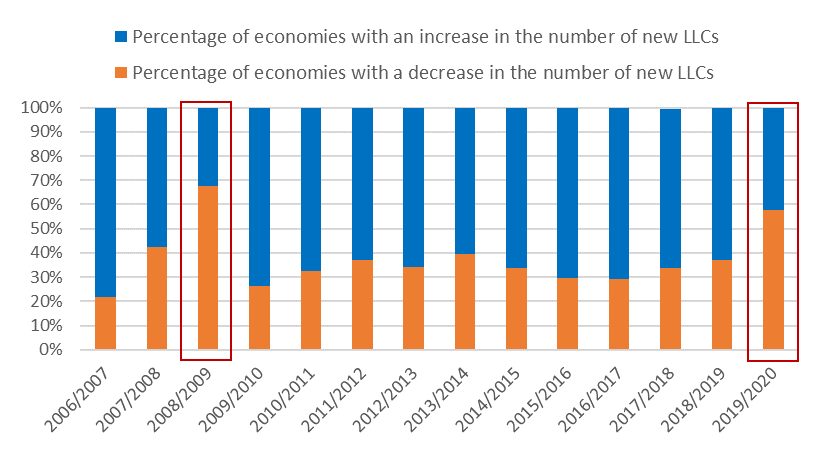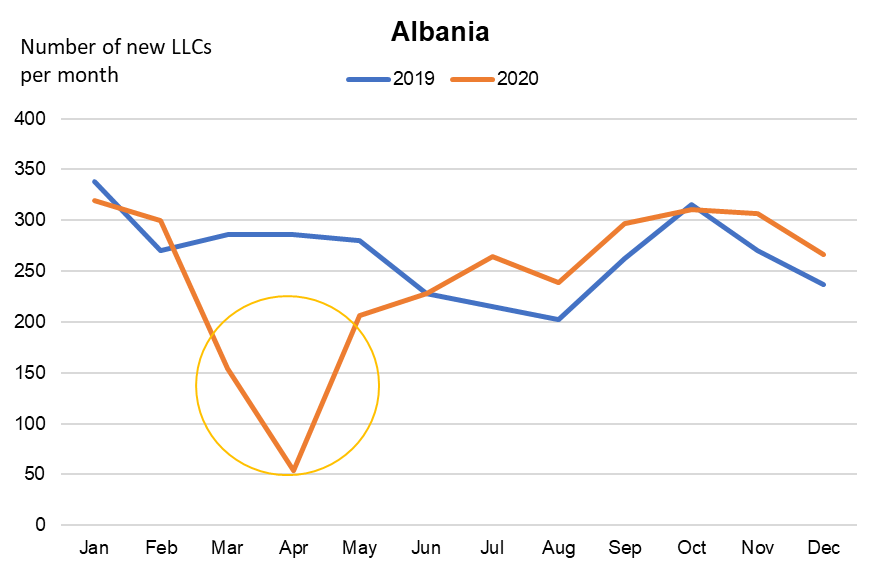 Small business owner serving customer in a cafe.
Small business owner serving customer in a cafe.
Business owners and aspiring entrepreneurs are often at the mercy of macroeconomic factors. When the COVID-19 crisis started, lockdowns reduced revenues of existing firms; cash flow turned negative for companies that could not cut operating costs. The pandemic also threatened the potential for innovation as access to capital and revenue became scarce for business start-ups.
New data from the World Bank Entrepreneurship Database - a longitudinal study of entrepreneurial activity - help understand the dynamics of business start-ups around the world. Data are collected directly from business registries, the entry point for entrepreneurs joining or transitioning to the formal sector. The latest edition included more than 170 economies and covered the period 2006-2020. The data are suggestive of of the impact of the COVID-19 crisis on new business registration.
Most Economies Experienced a Reduction in New Business Creation
In 2020 the number of newly registered firms - limited liability companies (LLCs) - fell in 58% of economies while the number of newly registered firms rose in only 42% of economies, compared to 2019. (Figure 1). This finding diverges from previous years, where the number of new firms tended to increase in most economies. Usually, in a given year, the number of new firms increases in about 2/3 of economies, while it slows down in 1/3 of economies.
Figure 1. While economies used to experience an increase in the number of new limited liability companies over time, the COVID-19 pandemic hit the pace of new business registration

Source: Entrepreneurship Database
The years 2009 and 2020 are the only two periods in the last 14 years where the number of economies with a drop in business entry was higher than those with an increase.
In 2009, 68% of economies experienced a drop in the number of registered firms. The degree to which the crisis affected new firm creation was highly correlated with measures of crisis severity in the financial sector. The financial crisis had a bigger negative impact on new business creation in economies with high levels of financial development, such as OECD high income economies. The number of affected economies, where the business registration decreased, was higher during the 2009 financial crisis compared to the COVID-19 crisis in 2020.
However, the COVID-19 crisis had a bigger impact on developing countries. Europe and Central Asia experienced the biggest drop in business entry in 2020: the number of newly registered firms dropped in 78% of Europe and Central Asian economies. This is followed by the Middle East and North Africa (75% of economies had a decrease in business entry) and the Latin America and the Caribbean (72% of economies had a decrease). On the contrary, 55% of OECD high-income economies in 2020 had an increase in business entry, because many of these economies provided considerable support to individuals and businesses to weather the crisis.
A Temporary Drop in Business Entry Was Common
In the spring 2020, when the World Health Organization (WHO) declared the COVID-19 outbreak as a pandemic and reiterated the call for countries to take immediate actions, many economies immediately experienced a pause in business registration, such as in Albania, Brazil, Cabo Verde and Pakistan (Figure 2).
Figure 2. The COVID-19 pandemic had a temporary effect on business creation (select economies)
 |
 |
 |
 |
Source: Entrepreneurship Database
With COVID-19 related restrictions in place, economic activity slowed down temporarily in many economies. Many economies experienced a temporary drop in business registration for a few months. On a yearly basis, there could be an overall increase despite the temporary drop. For instance, Brazil experienced an overall increase in new firms in 2020 but had a temporary drop in April and May, compared to 2019.
At the business registry, some months tended to be busier than others. The COVID-19 pandemic directly and momentarily impacted this seasonality in 2020.
What Was the Situation at the End of 2020?
The Entrepreneurship Database looks at entrepreneurship only in the formal sector and measures new business density - the number of newly registered limited liability firms per calendar year, per 1,000 working-age members of a country’s population. In 2020, the median new business density was the highest at 5.1 in OECD high-income economies (Figure 3). Estonia - with 24.2 new LLCs per 1,000 adults - had the highest new business density rate in the world. It benefited from its innovative E-residency policy allowing entrepreneurs to start a new business from abroad. It also attracted many British companies, which registered in Estonia to access the European market after Brexit. Other economies included Hong Kong SAR, China (19.2 new LLCs per 1,000 adults) and the United Kingdom (18.1 new LLCs per 1,000 adults).
Figure 3. The highest levels of entrepreneurship remain in OECD high income economies in 2020
Source: Entrepreneurship Database
The lowest level of entrepreneurship remained in Sub-Saharan Africa and South Asia, where less than 1 new LLC is created per 1,000 adults in 2020. While the new business density numbers were quite consistent across economies in South Asia, there was a wide dispersion in Sub-Saharan Africa. For example, the Democratic Republic of Congo and Liberia had less than 0.1 new LLC per 1,000 adults, Botswana and Cabo Verde had more than 13 new LLCs per 1,000 adults. Several regulatory reforms contributed to remove barriers to entry and help entrepreneurs being formal. In 2019, Cabo Verde introduced a new Commercial Code, simplified the business registration process at the one-stop shop for business start-up and introduced electronic minute books for new companies. In Botswana, the Companies and Intellectual Property Authority launched a mandatory online business registration system in 2019. The electronic system allowed entrepreneurs to reserve a unique company name and register the company electronically. Technology played a key role in helping local entrepreneurs be formal.
Digital Technology Had Never Been More Important for New Business Creation
The use of digital technology supported the continuity of services to businesses during the COVID-19 crisis. Economies with online company registration processes were able to ensure business continuity – keeping the business registry operational and tended to mitigate the impact of COVID-19 restrictions. The number of new businesses opened annually per 1,000 adults tends to be higher in economies where digital technology is widely adopted by people (Figure 4).
Figure 4. The higher the adoption of digital technology by people, the higher the level of business creation
Source and Note: The New business entry density in 2020 comes from the Entrepreneurship Database. The percentage of Digital adoption by people comes from the Digital Adoption Index 2016, World Bank Group. This is the most recent digital adoption data, and the relationship is also valid with the new business entry density in 2016. The relationship is significant at the 1% level.
Moving Forward
The latest round of the Entrepreneurship Database gives a first snapshot of the relationship between business creation and the recent COVID-19 crisis. Future editions of the Entrepreneurship Database could shed light on the pace of recovery in new business registrations following the crisis. One key element is access to digital technology, which can strengthen the path to recovery and unleash the potential of aspiring entrepreneurs.






Join the Conversation